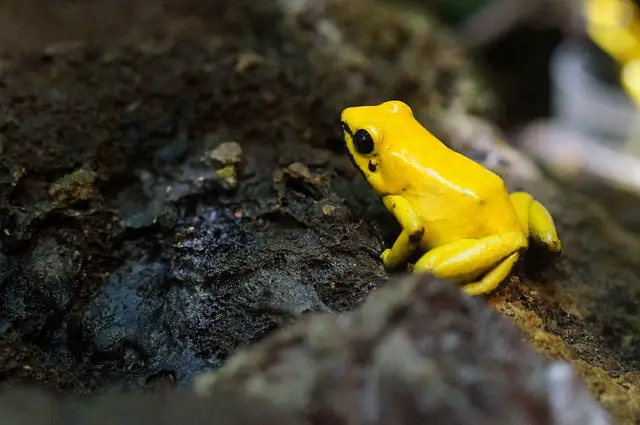Dart frogs make fascinating pets, but sometimes it can be difficult to figure out which species can live together. This comprehensive guide will help clear up any confusion and give you the information you need to create a thriving dart frog habitat!
Dart frogs that can live together (Considerations)
One of the most common questions we get asked is which dart frogs can live together. There are a few different factors to consider when trying to answer this question. The first is whether the species are from the same geographic region. If they are, then they are more likely to be compatible since they will be used to the same climate and food sources.
The second factor to consider is whether the species are of similar size. It’s generally not a good idea to house two species together if one is significantly larger than the other, as the smaller frog could become stressed or even injured. With these factors in mind, let’s take a look at some specific examples of dart frogs that can (and cannot) live together.
Dart frogs that can live together:
– Green and bronze poison dart frogs (Dendrobates auratus)
– Blue poison dart frog (Dendrobates tinctorius) and azureus poison dart frog (Dendrobates azureus)
– Mantella madagascariensis and M. pulchra
Dart frogs that should NOT be housed together:
– Green poison dart frog (Dendrobates auratus) and golden poison dart frog (Phyllobates terribilis) – these two species are from different geographic regions and have different care requirements
– Common reed frog (Hyperolius viridiflavus) and African Clawed Frog (Xenopus laevis)
– the African Clawed Frog is much larger than the Common Reed Frog and could easily injure or eat it
There are three main factors to consider when deciding which frogs can share a habitat: size, diet, and activity level.
Take into account size
Size is the most obvious factor to take into account. You don’t want to put two large frogs together in the same enclosure, as they may hurt each other during territorial disputes. Likewise, two small frogs may be bullied or simply unable to compete for food against their larger tank mates.
Diet
Diet is another important consideration. Some dart frogs are insectivores while others are omnivores, and it’s important to make sure that all of the frogs in your enclosure are getting the food they need. It’s also worth noting that some species of dart frogs are known to be cannibals, so it’s best to err on the side of caution and not put them together with other frogs.
Finally
Finally, activity level is something to keep in mind when choosing which frogs will share a habitat. If you have two very active frogs, they may bother or even injure each other in their efforts to explore their surroundings. On the other hand, two inactive frogs may not interact much at all and may become bored if they don’t have any other tank mates to liven things up.
By taking these factors into consideration, you can be sure to create a happy and healthy environment for your dart frogs. With a little planning, you can enjoy watching these colorful creatures thrive in their new home!
Conclusion
In conclusion, there are a few things to keep in mind when deciding which dart frogs can live together. The most important factors to consider are size, diet, and activity level. By taking these into account, you can create a safe and healthy habitat for your frogs. With a little planning, you can enjoy watching these fascinating creatures thrive!
FAQ’s
Q. How many dart frogs can I put in one enclosure?
A. This will depend on the size of your enclosure and the species of frog you are housing. It’s generally best to start with two or three frogs and then add more if the enclosure is large enough and the frogs seem to be doing well together.
Q. Can I put different species of dart frog together?
A. It’s generally not a good idea to mix different species of dart frog together, as they may have different care requirements or could even hurt each other. If you want to house more than one type of frog, it’s best to set up separate enclosures for each species.
Q. My frog isn’t interacting with its tank mates. Is this normal?
A. Activity levels can vary greatly from one frog to the next, so it’s not unusual for some frogs to be more active than others. If your frog seems happy and healthy, there’s no need to worry. However, if you notice that your frog is losing weight or becoming lethargic, it’s best to consult with a veterinarian.
Q. I think my frogs are fighting. What should I do?
A. If you see two frogs fighting, it’s best to remove one of them from the enclosure and put it in a separate tank. Once the frogs have had a chance to calm down, you can try putting them back together again and see how they do. If they continue to fight, it’s best to keep them in separate enclosures.




